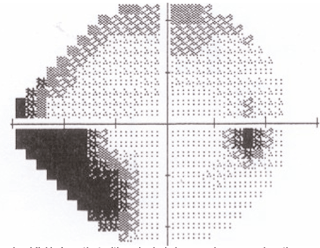 A 58-year-old white female presents seeking a second opinion about her glaucoma treatment. Another doctor had diagnosed her with primary open-angle glaucoma (POAG) three years earlier. She reports that she systematically tried all three available prostaglandin medications. She enjoyed their easy once-a-day dosing, but she eventually had to abandon each one due to extreme hyperemia or periorbital darkening induced by the medications. She subsequently underwent laser trabeculoplasty in each eye and is currently using timolol O.U.
A 58-year-old white female presents seeking a second opinion about her glaucoma treatment. Another doctor had diagnosed her with primary open-angle glaucoma (POAG) three years earlier. She reports that she systematically tried all three available prostaglandin medications. She enjoyed their easy once-a-day dosing, but she eventually had to abandon each one due to extreme hyperemia or periorbital darkening induced by the medications. She subsequently underwent laser trabeculoplasty in each eye and is currently using timolol O.U.
Her intraocular pressure (IOP) at todays examination is 20mm Hg O.D. and 19mm Hg O.S. A review of past records reveals that her initial IOP was 35mm Hg O.U. Laser trabeculoplasty brought it down to 26mm Hg O.U. And, with the addition of timolol, it appears that her IOP has been running in the high teens to low 20s for the past year.
She has moderately advanced glaucoma in each eye, and it appears that she must maintain an IOP level of 16mm Hg or less to prevent disease progression; however, she says that she doesnt like to use medications and is adamant that she will not be successful if she has to take more than one drug. She declines any incisional glaucoma surgery.
Clearly, she needs a lower IOP, and compliance with medications may be problematic. She strongly desires to use only one bottle. But, without being able to use a prostaglandin, it seems doubtful that any single agent will meet the target IOP. Timolol, which is one of the most effective IOP-lowering medications, reduces her IOP, but is inadequate alone in this case.
In order to meet the patients target IOP while maintaining ease of therapy, we discontinue the timolol and start the newest glaucoma agent: Combigan (brimondine tartrate 0.2%/timolol maleate 0.5%, Allergan). In this months column, we examine the science behind this new combination agent.
 What Is It?
What Is It?
Combigan is a fixed combination of brimonidine, an alpha-2 adrenergic agonist, and timolol, a beta blocker. It is used twice daily to reduce intraocular pressure. Both agents act complementarily to reduce IOP by suppressing aqueous production via different pathways.
While Combigan is the most recently approved glaucoma medication (and only the second available combination agent) in the
Two Drops in One
A multicenter, double-masked three-month study compared the IOP-lowering effect of the fixed brimonidine/timolol combination against each agent used alone. Mean IOP reductions from baseline were significantly larger with the fixed combination agent used b.i.d. than with either brimonidine or timolol monotherapy. At peak effectivity of each agent, the difference in IOP reduction was 1.5mm Hg greater with the fixed combination agent than either t.i.d. brimonidine or b.i.d. timolol. And, only 3.6% of patients discontinued the fixed combination due to adverse effects.1
One small-scale, 12-month trial found that the fixed combination drug, used b.i.d., had greater effectivity at all tested times vs. timolol used b.i.d. The fixed combination agent performed better than brimonidine used t.i.d. at all tested times except one (5:00 pm). And, in the brimonidine-treated patients, there was a greater incidence of adverse effects (conjunctival hyperemia, eye pruritus, follicular conjunctivitis, conjunctival folliculosis, allergic conjunctivitis, chemical conjunctivitis, conjunctival edema and blepharoconjunctivitis) than there was in the patients using the fixed combination agent.2
In this same study, the incidence of similar treatment-related adverse events in the fixed-combination group was higher than that in the timolol group. However, all serious adverse events (respiratory distress secondary to emphysema or tachycardia, sweating and nausea) occurred only in the timolol-treated group (consisting only of two patients). The rate of discontinuation due to adverse events was 30.6% with brimonidine, 14.3% with the fixed combination and 5.1% with timolol.2
The visual field of a patient with unchecked glaucoma. In cases such as the one we examine in this column, increased compliance with a medication regimen could reduce a patients chances of losing so much functional vision.

In a study comparing the fixed combination agent with concomitant use of brimonidine 0.2% and timolol 0.5% in patients with glaucoma and ocular hypertension, the fixed combination was found to be as effective as concomitant therapy with respect to mean IOP and mean change from baseline IOP at all time points and visits. There were no unexpected adverse effects with any treatment, and there was no difference in the rate of adverse events between groups.3
Another study examined the 24-hour control of IOP using the fixed combination agent compared to concomitant use of timolol and brimonidine (both used b.i.d.). There was a significant decrease from the untreated baseline IOP in both treatment groups. There was no statistical difference in IOP between the two groups at any time period, and there was a similarly low rate of local adverse events. The researchers concluded that the fixed combination agent provided virtually identical IOP reduction from baseline and diurnal IOP control as each of the two agents used concomitantly.4
A head-to-head comparison between the two FDA-approved combination agents, Cosopt (dorzolamide 2%/timolol 0.5%, Merck) and Combigan, found that there was a statistically similar reduction in IOP from baseline in patients with POAG and ocular hypertension with each combination agent. While there was no statistically significant difference in the rate of reported adverse effects between the two combination agents, patients reported more stinging upon instillation of Cosopt than with Combigan.5
Fixed combinations offer the benefits of convenience, cost and safety; however, they can limit individualization of dosing.6 Another unwanted occurrence with the use of combination agents: inappropriate usage together with its components (such as accidentally prescribing either timolol or Alphagan [brimonidine tartrate 0.2%, Allergan] with Combigan), especially after recent introduction.7
In the patient presented here, the replacement of timolol with Combigan was well tolerated. She was pleased that she did not have to change dosing schedules and could still use the medication b.i.d. Her IOP was consistently at or below target, and today, she is doing well with one bottle (albeit two therapeutic agents).
Combination agents can be very useful in the management of patients with glaucoma; they may allow patients to achieve target IOP using only one bottle, which in turn may enhance patient adherence to prescribed therapy.
Drs. Sowka and Kabat have no financial interests in any products or companies mentioned in this article, nor are they consultants or Speaker Bureau members for Allergan.
1. Craven ER, Walters TR, Williams R, et al. Brimonidine and timolol fixed-combination therapy versus monotherapy: a 3-month randomized trial in patients with glaucoma or ocular hypertension. J Ocul Pharmacol Ther 2005 Aug;21(4):337-48.
2. Sherwood MB, Craven ER, Chou C, et al. Twice-daily 0.2% brimonidine-0.5% timolol fixed-combination therapy vs. monotherapy with timolol or brimonidine in patients with glaucoma or ocular hypertension: a 12-month randomized trial. Arch Ophthalmol 2006 Sep;124(9):1230-8.
3. Goi FJ; Brimonidine/Timolol Fixed Combination Study Group. 12-week study comparing the fixed combination of brimonidine and timolol with concomitant use of the individual components in patients with glaucoma and ocular hypertension. Eur J Ophthalmol 2005 Sep-Oct;15(5):581-90.
4. Konstas AG, Katsimpris IE, Kaltsos K, et al. Twenty-four-hour efficacy of the brimonidine/timolol fixed combination versus therapy with the unfixed components. Eye 2007 Jun 15. [Epub ahead of print]
5. Arcieri ES, Arcieri RS, Pereira AC, et al. Comparing the fixed combination brimonidine-timolol versus fixed combination dorzolamide-timolol in patients with elevated intraocular pressure. Curr Med Res Opin 2007 Apr;23(4):683-9.
6. Fechtner RD, Realini T. Fixed combinations of topical glaucoma medications. Curr Opin Ophthalmol 2004 Apr;15(2):132-5.
7. Kaiserman I, Kaiserman N, Nakar S, et al. The effect of combination pharmacotherapy on the prescription trends of glaucoma medications. J Glaucoma 2005 Apr;14(2):157-60.

